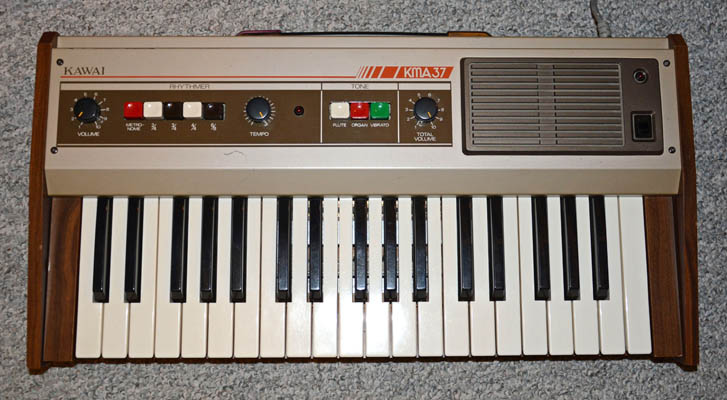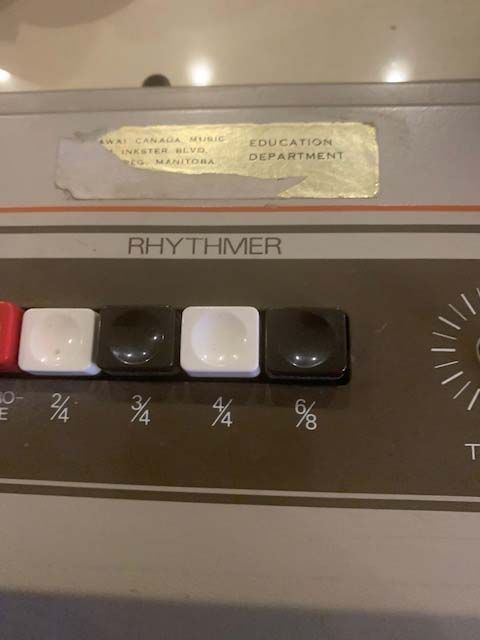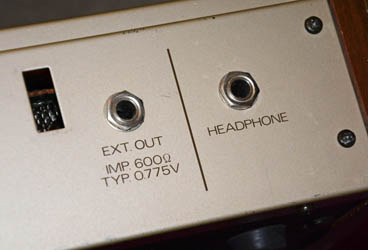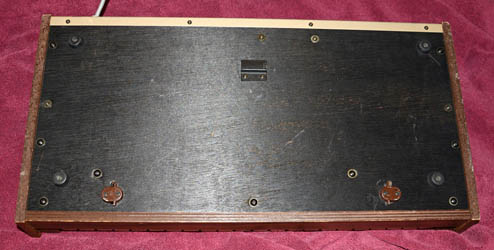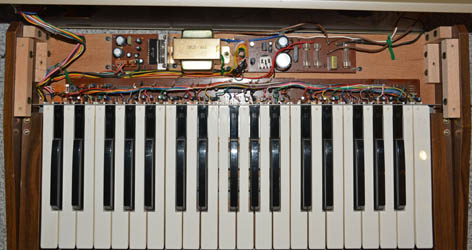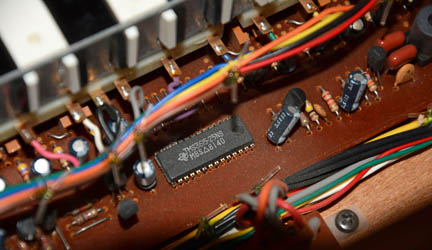Kawai KMA-37Portable Electronic OrganMade in 1981 by Kawai Musical Instruments of Hamamatsu, Japan, my KMA-37 is a strange little keyboard. It is a polyphonic sustained-tone instrument with divider-based generation and subtractive filtering, thus belonging to the electronic organ category—nothing special so far. What makes it unique is that despite high build quality and a name brand, it is among the most musically limited electronic organs ever made. There are only three controls related to timbre: two stops at unison pitch ("flute" and "organ"), and a vibrato control, all just on/off buttons. Its range of 37 keys is narrower than any standard organ manuals, including those of spinets (44 keys) and most "real" combo organs (48/49 or 60/61 keys). These deficiencies alone are not fatal — if given a medial pitch range and good stop voicing, it could make a decent chord or melody machine. Or even better, if given a low pitch range, it could make a fine key-bass, since the bass end is truly the province of short keyboards. Yet, astoundingly, Kawai chose a high pitch range of C4 to C7—too high to play many typical melodies and chords—and compounded things even more with weakly-voiced stops. To top it off, in classic 70s/80s home-organ fashion, the remaining yen go towards a hilariously cheesy and basic analog drum machine, instead of more satisfying stops and effects. The presets of this "Rhythmer" consist of a bass drum on the first beat, and a snare-like drum (really just a puff of noise) on every subsequent beat; "metronome" eliminates the bass drum. Needless to say, this is a rare instrument. When I first published the article in late 2014, there was only one reference to this model online, which is that one was repaired in 1990; see here. Kawai's websites do not have any info, so in July of 2014, I contacted Kawai US, asking if they had any documentation. The answer was no—neither the fellow I contacted nor his Japanese colleagues had any record of its existence, let alone documentation. Since then, two more KMA-37s have surfaced; one for sale on a Japanese auction site, and one found at a thrift store in nearby Calgary, Alberta. Aside from discovering those, no other info has come about. I've also found nothing on any other KMA series instruments; if they exist, they would probably be similar except with different numbers of keys, considering this KMA-37 has 37 keys. Perhaps the biggest question is "for whom was this instrument intended?" The functionality is most similar to toy organs, yet the build quality indicates that it is not a toy—from the full-size keys with a great feel, to the sturdy metal and wood cabinet, it displays a quality that even at the time was becoming rare, and which is now especially rare. By the 1980s, only professional instruments were as well-built in general, but of course the KMA-37 is almost useless as such, for reasons already explained. My best guess is that it was intended as a portable practice keyboard for music students. Further suggestion of this was provided by the owner of the other KMA-37 in Calgary, showing it belonged to the Education Department of Kawai Canada: To give some background, I found my own KMA-37 at a thrift store in Lacombe, Alberta for $10.00 in August of 2013—it had just come in, and upon seeing it, I knew it was something of interest. I have not had to perform any real repairs; I simply cleaned the pots with Electrosolve, and applied a bit of glue to stabilize a crack in one wood block. I also figured out where the tuning control was, and adjusted it—see the Hardware section. In any case, I publish this article to serve as the only source of info on this musical anomaly. If you own a KMA-37, please contact me, since I would like to know if any more of these still exist. Features
Trivialities
HardwareThe instrument's build quality is good for 1981, being also better than modern keyboards in general, but worse than older ones. Its body is made of metal and "wood"—the latter is mostly particle-board and plywood with fake-woodgrain veneer, plus a few solid hardwood mounting blocks. I do find it rather funny that the most cosmetically important "wood" panels are made of the cheapest and fakest materials, while the real quality woods are reserved for structural pieces not visible from the outside. This is typical of the 1980s, and partly explains why people were accepting of 99%-plastic products when they came about—the so-called "woods" were already blatantly fake and flimsy by that point anyway. The metal top cover is held by 12 screws in order to give enough strength for the instrument to be carried by a handle mounted to the cover. On the back can also be seen the builder's plate, the two outputs, and two rectangular holes, which are probably for mounting a long-gone music stand. The "EXT. OUT" does not interrupt the internal speaker, while the "HEADPHONE" output does. As expected, the "HEADPHONE" output makes a nice high-level output for recording and external amplification, but take care to use stereo connectors so as not to short out the right channel. There is another peculiar feature on the back. Have you spotted it? Check out the heavy-duty chrome-plated TEISCO end caps on the handle! Teisco was a Japanese company that made guitars, amps, and combo organs in the 1960s especially. Kawai bought Teisco in 1967 and discontinued the brand in 1969 except as applied to electronic keyboards, which continued "until the 1980s" according to Wikipedia, so this explains the connection company-wise. I then tried to find a connection on the instrument level, researching Teisco keyboards of the same era. The Teisco Synthesizer 110F uses two of the same knobs, and the text font is the same; it is the strongest connection I've found to Teisco instruments. There is also some connection to Kawai home organs of the same era (such as the DX900), some of which use the same buttons, and the same lettering font. Below shows the bottom of the instrument. Towards the front, there are two brown plastic pieces spaced the same horizontally as the rectangular holes in the back. I suspect these pieces, along with the metal bracket in the middle, were designed to hold a metal wire music stand to the bottom when not in use. I imagine something similar to the stands on Hewlett Packard test gear such as the 651B; you can look it up to see what I mean. However, I cannot imagine a plain metal wire stand mounting properly to the rectangular holes in the back, so it is still not certain what kind of design was used. Removing the twelve screws and carefully moving the metal panel out of the way reveals the insides: The electronics are typical for 1981. As many functions as possible are implemented with ICs: the voltage regulation, tone generation, amplification, and more. Unfortunately, this makes this instrument more difficult to repair than earlier organs made with discrete parts, since some of the ICs are long out of production and increasingly scarce, whereas discrete parts are still in production and common. Especially the TMS3615-25NS tone generators are rare, and would be difficult to substitute. In fact, I can only find TMS3615NS for sale in the proper shrink-dip package, and I don't know the difference between it and the -25NS; my guess is that it would probably work, but I can't say for sure. The TMS3615NL in a normal DIP package was widely used, especially by Italian companies such as Crumar, Farfisa, GEM, Siel, and so on. Near the left end of the left tone generator board, there is a variable inductor, seen cut-off in the upper right corner of the above image. This is the master tuning adjustment—rotating its core tunes all notes on the keyboard. Use a plastic screwdriver, and be very careful so as not to crack the brittle ferrite. The small oval-shaped internal speaker can produce a moderately loud output, as it is driven by a Sanyo LA4230 "6-8 watt" amplifier chip. Neither of the volume controls can actually be turned all the way down; a small amount of signal comes through at minimum setting. The internal wiring harnesses are neatly arranged and laced with clear plastic cord—very common in this era of Japanese equipment—and most connections between boards are made with 0.1" connectors, which would make removing and replacing boards quite easy. A reader in Ukraine known as T-150 (named after the Soviet tractor) has kindly sent me the datasheet for the TMS3615-NS tone generator chip, which I have uploaded here—I believe this will be its first time online. As can be seen, this chip takes one high-frequency clock as input, and divides this frequency by certain factors (listed on page 8) to give 13 square-wave pitches spanning one octave, spaced in semitones—these pitches comprise the 8' register. The 8' pitches are each divided by 2 (i.e. lowered an octave) to create the pitches comprising the 16' register. Each pitch is fed to its own "analog modulator" (i.e. variable-gain amplifier), which modulates the amplitude based on the "sustain bias" voltage, as well as the voltages on the 13 key inputs. The outputs of the 8' modulators are summed to a single 8' output, and similarly for the 16'. This leaves little to do outside of the chips—just combination, tone shaping, and effects. You may wonder why the chip produces 13 notes instead of 12. This is so that the keyboard's range can start and end on the same note. Have a look; how many C keys are there? Four, yet there are only 3 tone generator chips. Either the lowest or highest chip is responsible for two C keys; I don't know which, since I still have no schematic, nor have reverse-engineered it, nor does it really matter. If the chips only gave 12 notes, the instrument's range would likely be from C to B. Note as well that the "sustain" features of the chip are not used by the KMA-37. The manual states that sustain of the notes is possible by adding a 1µF capacitor to each key input, and that the sustain time is adjustable ("from a few ms to a very long time") by adjusting the voltage on pin 4 ("SUSTAIN BIAS"). For now at least, my preservationist nature prevents me from modifying this instrument to try it out—it is enough for me to know that it is possible. I should note, however, that already there is a very short yet noticeable "sustain" time, as well as a short "attack" time. The SoundsFiltering is typical of formant-style organs, and in fact less sophisticated than even the very first commercial instruments of its class. The "flute" tone is mellow, roughly triangular in shape. It appears to result from lowpass filtering of the 16' squarewaves from the tone generator chips. The "organ" tone is brighter, though still weak in high harmonics, and it appears to result from lowpass-filtering the 16' and 8' squarewave signals summed in equal proportion. See the images below: Note how the waveforms become both smoother and lower in overall amplitude with increasing pitch, as the fundamental frequencies approach and pass filter "cutoff". Note how the "flute" voice begins as a rounded square wave at C4, becoming a fairly good triangle by C7, as expected from a 1-pole lowpass filter fed a square wave input. The "organ" voice also begins close to the summation of 16' and 8' squares of equal amplitude, yet also approaches a triangular shape. Anyway, I shall not say more without doing proper circuit-tracing. Having both "stop" buttons pressed in at once combines them additively. As mentioned before, there is a very short "attack" time at the beginning of a keypress, and a similarly short "sustain" time at the end, further reducing the boldness of the sounds. The vibrato is as basic as possible, with a medium frequency and low depth. It is easy to forget that you've turned on the vibrato once it's been on for a while. The "Rhythmer" is a neat little drum machine, also very simplistic. There are 5 on/off buttons for selecting the rhythm pattern: metronome, 2/4, 3/4, 4/4, and 6/8. Buttons to the left override buttons to the right, however the 6/8 button doubles the speed of all rhythms no matter what. Each beat consists of a burst of noise controlled by a simple volume envelope (sounding similar to a snare drum), with the downbeat also including a low frequency "blip", giving a sound vaguely like a bass drum. The simple snare and bass drum combination calls a marching band to mind. Probably the best use for the KMA-37 is as a lead instrument with some overdrive/distortion. One example of this can be found on my 2014 album Demos, or perhaps not..., on the track "Sixties Five", where I use it with a wah pedal and a homemade "Valve Caster" tube overdrive, which has fairly low gain and gives a dark, crunchy sound. It also makes an appearance on my album Ридахций at the 22:26 mark, where the rhythmer is used to produce a repeating pattern of 11, 10, 9, ..., 3, 2, 1 beats, by means of quickly activating and deactivating the 2/4 button. Neither of these are especially great performances—my ability and tastes have improved since then, though the albums still have worthwhile moments. Maybe at some point I will make a proper demo, but it is low on the priorities, unless it is requested. Links
|
| If you notice any errors or have additional information that you would like to add, please contact me! |
First Published: 10/17/2018
